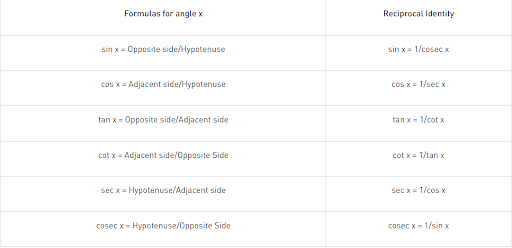Find the angle in radian though which a pendulum swings if its length is 75 cm and the tip describes an arc of length
(i) 10 cm (ii) 15 cm (iii) 21 cm
Find the angle in radian though which a pendulum swings if its length is 75 cm and the tip describes an arc of length
(i) 10 cm (ii) 15 cm (iii) 21 cm
Solution and Explanation
We know that in a circle of radius r unit, if an arc of length / unit subtends an angle θ radian at the centre, then .
\(θ=\frac{i}{r}\)
It is given that r = 75 cm
(i) Here, l = 10 cm
\(θ=\frac{10}{75}\,radian=\frac{2}{15}\,radian\)
(ii) Here, l = 15 cm
\(θ=\frac{15}{75}\,radian=\frac{1}{5}\,radian\)
(iii) Here, l = 21 cm
\(θ=\frac{21}{75}\,radian=\frac{7}{25}\,radian\)
Top Questions on Trigonometric Functions
- The integral \[ \int_0^\pi \frac{8x}{4\cos^2 x + \sin^2 x} \, dx \text{ is equal to:} \]
- JEE Main - 2025
- Mathematics
- Trigonometric Functions
- The value of \( \cos \left( \sin^{-1} \left(-\frac{3}{5}\right) + \sin^{-1} \left(\frac{5}{13}\right) + \sin^{-1} \left(-\frac{33}{65}\right) \right) \) is:
- JEE Main - 2025
- Mathematics
- Trigonometric Functions
- If \( \alpha>\beta>\gamma>0 \), then the expression \[ \cot^{-1} \beta + \left( \frac{1 + \beta^2}{\alpha - \beta} \right) + \cot^{-1} \gamma + \left( \frac{1 + \gamma^2}{\beta - \gamma} \right) + \cot^{-1} \alpha + \left( \frac{1 + \alpha^2}{\gamma - \alpha} \right) \] is equal to:
- JEE Main - 2025
- Mathematics
- Trigonometric Functions
- Evaluate the limit: \[ \lim_{x \to 0} \csc{x} \left( \sqrt{2 \cos^2{x} + 3 \cos{x}} - \sqrt{\cos^2{x} + \sin{x} + 4} \right) \] is equal to:
- JEE Main - 2025
- Mathematics
- Trigonometric Functions
Let \( M \) and \( m \) respectively be the maximum and the minimum values of \( f(x) = \begin{vmatrix} 1 + \sin^2x & \cos^2x & 4\sin4x \\ \sin^2x & 1 + \cos^2x & 4\sin4x \\ \sin^2x & \cos^2x & 1 + 4\sin4x \end{vmatrix}, \quad x \in \mathbb{R} \) for \( x \in \mathbb{R} \). Then \( M^4 - m^4 \) is equal to:
- JEE Main - 2025
- Mathematics
- Trigonometric Functions
Questions Asked in CBSE Class XI exam
Draw the Lewis structures for the following molecules and ions: \(H_2S\), \(SiCl_4\), \(BeF_2\), \(CO_3^{2-}\) , \(HCOOH\)
- CBSE Class XI
- Kossel-Lewis Approach to Chemical Bonding
- The following results are observed when sodium metal is irradiated with different wavelengths. Calculate (a) threshold wavelength and, (b) Planck’s constant
λ (nm) 500 450 400 v × 10–5(cm s–1) 2.55 4.35 5.35 - CBSE Class XI
- Atomic Models
- Briefly comment on "The purpose of the author’s journey to Mount Kailash."
- CBSE Class XI
- Silk road
- Prove that. \(2sin^2 \frac{π}{6}+cosec^2 \frac{7π}{6}–cos^2 \frac{π}{3}=\frac{3}{2}\)
- CBSE Class XI
- Trigonometric Functions of Sum and Difference of Two Angles
- Prove that sin x+sin 3x+sin 5x+sin 7x=4 cos x cos 2x sin 4x.
- CBSE Class XI
- Trigonometric Functions of Sum and Difference of Two Angles
Concepts Used:
Trigonometric Functions
The relationship between the sides and angles of a right-angle triangle is described by trigonometry functions, sometimes known as circular functions. These trigonometric functions derive the relationship between the angles and sides of a triangle. In trigonometry, there are three primary functions of sine (sin), cosine (cos), tangent (tan). The other three main functions can be derived from the primary functions as cotangent (cot), secant (sec), and cosecant (cosec).
Six Basic Trigonometric Functions:
- Sine Function: The ratio between the length of the opposite side of the triangle to the length of the hypotenuse of the triangle.
sin x = a/h
- Cosine Function: The ratio between the length of the adjacent side of the triangle to the length of the hypotenuse of the triangle.
cos x = b/h
- Tangent Function: The ratio between the length of the opposite side of the triangle to the adjacent side length.
tan x = a/b
Tan x can also be represented as sin x/cos x
- Secant Function: The reciprocal of the cosine function.
sec x = 1/cosx = h/b
- Cosecant Function: The reciprocal of the sine function.
cosec x = 1/sinx = h/a
- Cotangent Function: The reciprocal of the tangent function.
cot x = 1/tan x = b/a
Formulas of Trigonometric Functions:
